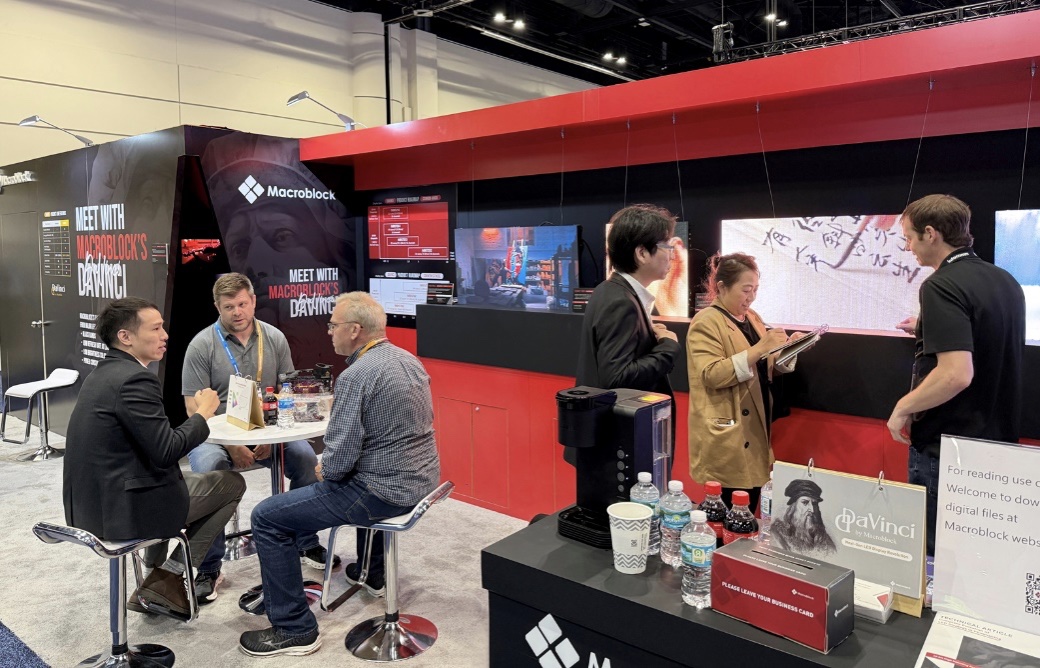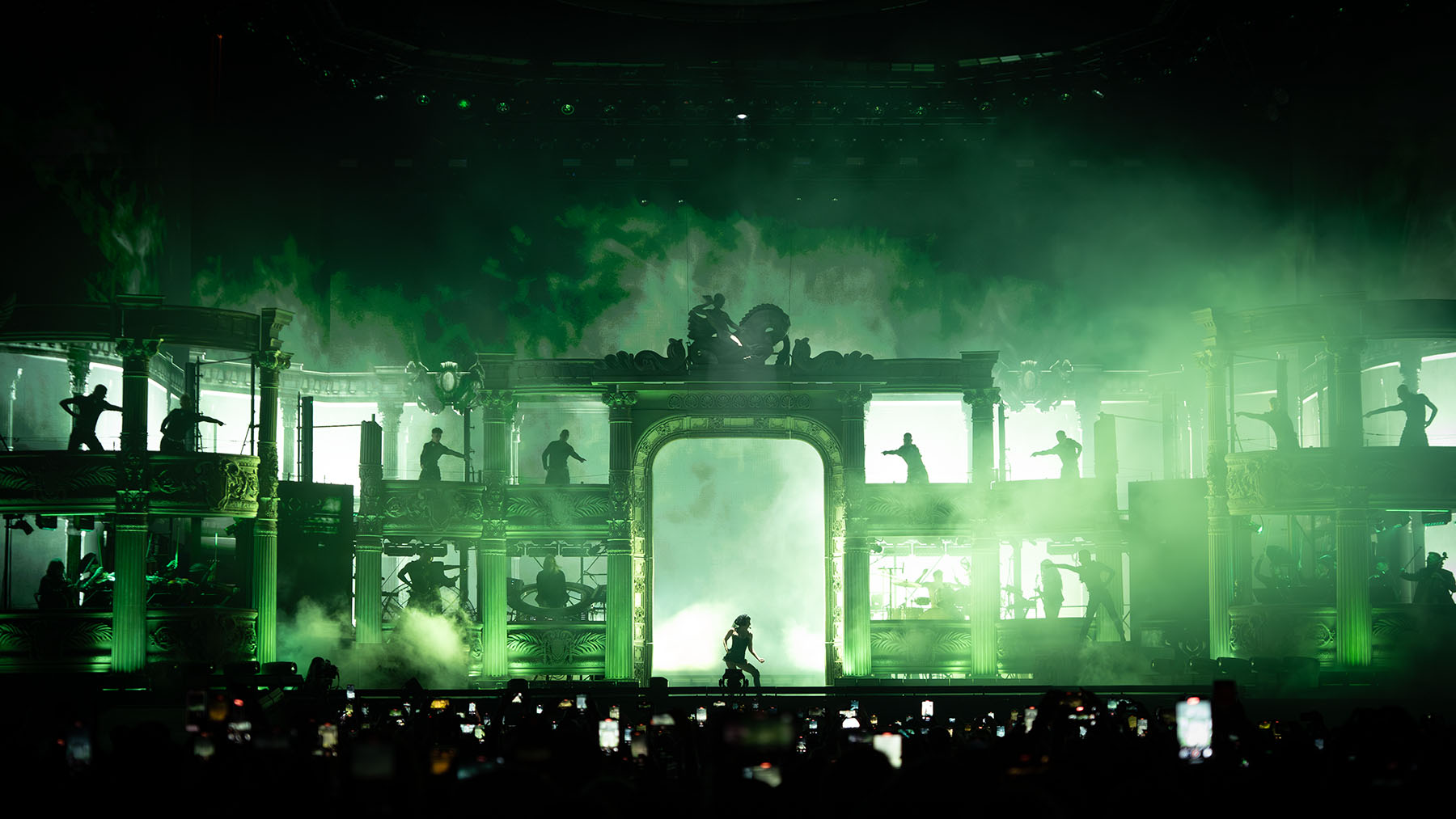LONG BEACH, CA — SMG worked with John Sergio Fisher Architects, Theatre Projects Consultants and Jerry Sherman, AIA to update the Long Beach Arena with a new tension grid rigging system provided by J. R. Clancy, Inc.
More details from J. R. Clancy (www.jrclancy.com):
Bringing unprecedented flexibility and ease of use to a decades-old arena space takes vision, imagination, and the ability to see new possibilities. That’s what Steve Goodling, president and CEO of the Long Beach Convention and Visitors Bureau, brought to the table for the transformation of Long Beach Arena.
 Working with the nationwide facilities management company SMG, Long Beach set out to bring this vision to reality. Led by Charlie Bierne, the SMG management team assembled a design collaborative including John Sergio Fisher Architects, Theatre Projects Consultants and Jerry Sherman, AIA.
Working with the nationwide facilities management company SMG, Long Beach set out to bring this vision to reality. Led by Charlie Bierne, the SMG management team assembled a design collaborative including John Sergio Fisher Architects, Theatre Projects Consultants and Jerry Sherman, AIA.
To execute the innovative system the design team conceived—and to turn the job around in less than a year—the City of Long Beach selected the entertainment rigging design and manufacturing company J. R. Clancy, Inc.
The arena, originally designed as a sports venue for hockey and basketball, had expanded its client base dramatically since it opened in the 1960s. Today it accommodates a much wider range of events: concerts, sporting events, fashion shows, lectures, receptions, dinners, large-scale performances, and more, but its original construction did not permit the kind of flexibility and fast turnarounds its modern uses require.
 At the heart of the team’s design for the renamed Pacific Ballroom at Long Beach Arena is the largest flying truss and tension grid system in the United States. The one-of-a-kind movable grid system would change the antiquated arena into a grand ballroom or a series of smaller spaces, as clients and events required.
At the heart of the team’s design for the renamed Pacific Ballroom at Long Beach Arena is the largest flying truss and tension grid system in the United States. The one-of-a-kind movable grid system would change the antiquated arena into a grand ballroom or a series of smaller spaces, as clients and events required.
“What we’ve created is essentially a technical ceiling,” said Michael Ferguson, project director with Theatre Projects Consultants. “It’s a large, metal structure that weighs tens of thousands of pounds. It’s the only tension grid in the world that can fly up and down. A surrounding curtain wall comes down and creates the side walls.”
“With a full truss system and curtains, you have the ability to have a full house, a third house, or a two-thirds house,” said Bierne, who serves as general manager of Long Beach Convention and Entertainment Center. “We can do receptions, we can do pop concerts, we can do auto shows with individual lights on the autos. We have lights installed, and sound installed. This breathes new life into an existing space.”
“The people at SMG really worked closely with us to make this transition, even scheduling events around our installation schedule,” said Mike Murphy, J. R. Clancy president. “They knew the benefits this system would bring to them, so they were willing to accommodate our needs for access to the arena.”
Brett Cooper, contract project manager with J. R. Clancy, moved to Long Beach and served as on-site project management for all of the trades in the arena space. In addition to serving as the lead contractor on the project, J. R. Clancy provided the high-capacity hoists and the control system for this innovative grid configuration, and also installed all of the lighting and sound infrastructure. Clark-Reder Engineering, Inc., designed the structural steel for the building modifications to support the new tension grid and the additional load various productions will require.
The three-piece traveling tension grid contains more than $1.6 million in fully integrated LED lighting instruments, hanging over the 45,000-square-foot convention floor.
“It’s a flying catwalk system,” said Bridget Cox, director of project management for J. R. Clancy. “The tension grid panels are flown in with three big hoists—and each of the hoists has a capacity of 84,000 pounds. These allow the tension grid to travel from floor level to a storage position sixty feet above the floor. They can use the grid for personnel access to hang lighting, mount speakers, and have a fully flexible, versatile space.”
In addition to the capacity for lighting and sound equipment, there were also perimeter and divider curtains provided that help configure the arena space into smaller event areas. “The perimeter curtains are motorized brail,” said Cox. “Eight of these perimeter curtains form a complete oval around the floor space. The trusses have self-climbing hoists inside of them, so the operator can bring the curtain up, and the trusses can fly up as well.”
A two-person skyclimber above the grid allows personnel to access the assembly by riding down to it. Walkways join the grid sections together, allowing as many as fifteen people to be on the grid itself—should a touring show bring additional equipment to hang from the grid, for example.
The entire system can be controlled from a simple interface developed by J. R. Clancy specifically for this project. Using the wireless pendant controller, an operator can raise and lower the grid sections from anywhere in the ballroom.
“We incorporated a true emergency stop into a wireless automation system, which requires a higher level of functional safety,” said Tom Zorn, controls hardware developer at J. R. Clancy. Zorn worked closely with Larry Eschelbacher, J. R. Clancy director of engineering, on the development of the control system. “It’s built on the Siemens Functional Safety Model, a higher level of program that is robust enough to prevent interference from other signals in the room. The control system is used pre-show to set the equipment in a specified position, and will not be used during a performance.”
Changeovers that once required a large crew can now be done in a matter of minutes—raising or lowering the ceiling, lowering the draperies, and changing the lighting to create the desired atmosphere for the next event.
The Long Beach Post reports that this repurposing of the Long Beach Arena cost “a fraction of what it would have been to build an entirely new ballroom structure. The return on investment, then, will be huge.”
More details from Theatre Projects Consultants (http://www.theatreprojects.com)
 Long Beach Arena Reborn with State-of-the-Art Technology
Long Beach Arena Reborn with State-of-the-Art Technology
NORWALK, CT — To call the last two years of work on the Long Beach Arena “a renovation” would be a substantial understatement. In reality, the work done by Theatre Projects, working for John Sergio Fisher Architects, Jerry Sherman AIA, and the city of Long Beach, could more accurately be described as a reinvention—breathing new life and new commercial potential into a venue that—at 50 years old—had fallen behind its newer, larger competitors, and found itself unsuited to meet the needs of some potential clients.
 As the arena creates a new identity for smaller events—The Pacific Ballroom at Long Beach Arena—and begins hosting concerts, receptions, fashion shows, sporting events, and numerous other events, it will do so at a pace and with an ease-of-use unrivaled in the convention industry. This newfound viability is thanks in large part to a one-of-a-kind moveable grid system that allows organizers to change from arena to ballroom, and alter the lighting and audio configurations with little more than the flick of a switch.
As the arena creates a new identity for smaller events—The Pacific Ballroom at Long Beach Arena—and begins hosting concerts, receptions, fashion shows, sporting events, and numerous other events, it will do so at a pace and with an ease-of-use unrivaled in the convention industry. This newfound viability is thanks in large part to a one-of-a-kind moveable grid system that allows organizers to change from arena to ballroom, and alter the lighting and audio configurations with little more than the flick of a switch.
Responding to Long Beach Arena’s need for versatility and the ability to tailor their venue to each client’s unique needs, we contributed to the design of one of the country’s largest flying truss and tension grid systems. The expansive grid, which has more than $ 1.6 million in LED lighting integrated into it, can be lowered over the 45,000-square-foot convention floor to any desired height, helping define the new ballroom. Curtains hung from a surrounding truss are lowered, obscuring the view of the arena seats, creating a separate, intimate space on the arena floor. The ballroom, capable of seating up to 5,000 guests, can be customized into any seating configuration desired, and the built-in audio and lighting systems adapted in infinite arrangements.
Michael Ferguson, project director for Theatre Projects, said, “What makes it amazing is not just that it has the ability to have different configurations—it can be used for boxing, fashion, banquets, or TED Conferences—it’s the ability to do all those things and turn over between them very quickly. They can have a church service, a concert, and then a graduation in three consecutive nights. If you need a 40,000-foot space for a sit-down dinner, you can do it; Disney on Ice or Cirque du Soleil—they could do that as well.”
The benefit of a highly adaptable venue is essentially lost if making that adaption is too cumbersome, time consuming, or labor intensive. The Pacific Ballroom was designed as a turnkey operation—allowing the organizers to adjust the size and shape of the room, lighting, and audio configurations with a minimum of time and effort.
“Previously, you would need to hire a whole crew of workers to hang trusses, lights, and speakers, and of course, you would need to give them the time to set up,” Ferguson said. “Now you don’t need to hire an entire crew just to create a more intimate space within the arena. With this system, within five minutes and 10 keystrokes, you could lower the ceiling, lower the draperies, and create completely immersive lighting throughout the ballroom.”
In allowing the organizers to rapidly rearrange the ballroom for each event, the arena can turnover an unprecedented number of clients—and in doing so—exponentially increase their revenue.
“The cost [of hosting an event] can be cut in half, or even 80 percent,” said Daniel Clancy, vice president of sales and event services at San Diego-based Vision Global Event Strategies.
By opting to reinvent the arena, creating a smaller, flexible venue, The Long Beach Arena is now capable of hosting a myriad of events and attracting a new, divergent clientele it couldn’t previously consider. In taking this innovative approach—electing not to out-build the larger regional stadiums—the arena not only saved more than $100 million in construction, but also avoided the countless environmental hazards such a project would have created.
“When a city has a portfolio, adding vital pieces is important in tough economic times,” Ferguson said. “It’s important to spend money on something that adds value to the community. It’s a well-beloved institution; now they’re breathing new life into it for the next 50 years. We think it will triple or quadruple their ability to use that space.”
For a city that once thrived on attracting conventions, the Pacific Ballroom at Long Beach Arena is set to reignite the appeal of the waterfront venue, and in doing so, elevate not just the immediate area but the entire city of Long Beach.



